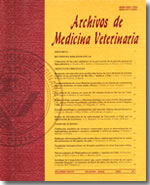Glutathione S-transferase activity in synovial membrane of normal and altered equine metacarpophalangeal joint
Main Article Content
Abstract
The activity of glutathione S-transferase (GST) has been described in the cytosol and microsomes from cells of various tissues, where it catalyzes the conjugation of glutathione with xenobiotics. This activity also has an important role related to the inactivation of free radicals. The GST activity was measured in the synovial membrane of the metacarpophalangeal joint from equine aged between 1.5 and 4 years, coming from slaughterhouses, without distinction as to sex. According to the macroscopic appearance, joints samples were classified as normal (n = 16), or altered (n = 16). Both the normal synovial membranes and the altered were grouped into 4 sets of 4 samples each. In the synovial fluid and in each of these sets the concentration of proteins was measured. The GST activity was measured in the homogenized, cytosolic and microsomal fractions. Also, values of Kmapp and Vmaxappwere estimated for each of the fractions in order to characterize the enzymatic activity. The results show that the GST activity is present in all analyzed fractions. Values of Vmax and Vmax/Km turned out to be significantly lower in the altered samples when compared to the normal ones. Moreover, the GST affinity for their substrates decreased significantly. This result can be explained by modification of chemical groups of the oxidative stress-induced enzyme that undergo altered samples. Alternatively, the expression of enzymes with different kinetic parameters (isoenzymes) could account for the difference between normal and altered samples.

